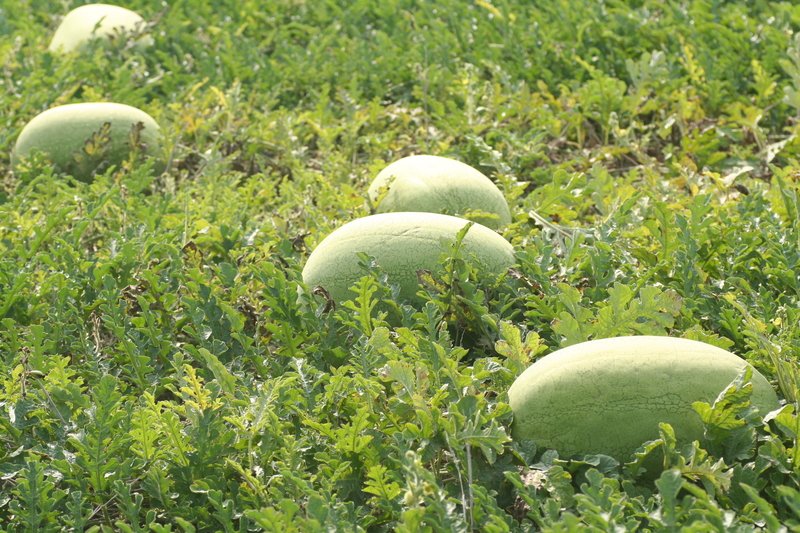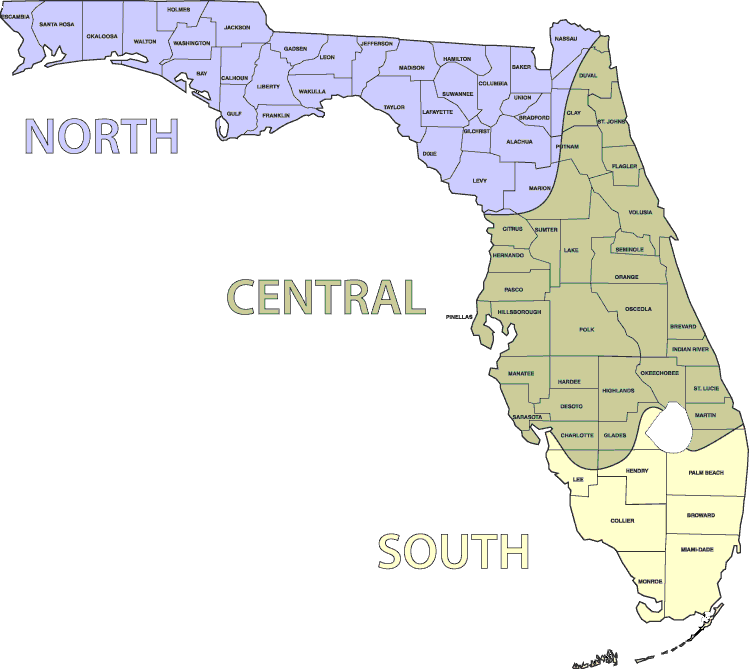Melon Varieties for Florida
Watermelons and muskmelons, with their sprawling vines and sweet, juicy fruits, bring a delightful and refreshing touch to any garden. Known for their vibrant green rinds and fragrant, netted skins, these melons are a summertime favorite. Their long, trailing vines and broad leaves create a lush ground cover, making them a striking addition to garden beds or spacious containers.
In Florida planting zone 9, both watermelons and muskmelons thrive during the warm months. Watermelons develop into sizable fruits with sweet, red flesh, while muskmelons mature into aromatic melons with a variety of flesh colors, from orange to green. Watching these fruits grow and ripen is a delightful experience, promising a delicious reward for your gardening efforts.
For those new to gardening, watermelons and muskmelons are fun and rewarding choices. They require ample space and warm weather but can be very productive, offering large, sweet fruits perfect for enjoying fresh or in a variety of summer dishes. These melons bring a refreshing and hydrating treat to your meals, making your gardening endeavors both enjoyable and fruitful.
I would give both watermelons and muskmelons a 3 out of 5 on how easy they are to grow. They require some space and attention to watering, but with the right conditions, they are manageable for beginners.
Watermelon Varieties:
Sugar Baby
Heirloom

Description: Sugar Baby is a popular icebox watermelon variety known for its small size, dark green rind, and sweet, red flesh.
Growing Season: Spring and Summer
USDA Planting Zone: 3-9
Special Notes: Ideal for small gardens and quick to mature. Matures in about 75-80 days.
Charleston Gray
Heirloom

Description: Charleston Gray is a large watermelon variety with a light green rind and sweet, red flesh. It is known for its excellent flavor and high yields.
Growing Season: Spring and Summer
USDA Planting Zone: 3-9
Special Notes: Resistant to fusarium wilt and anthracnose. Matures in about 85-90 days.
Crimson Sweet
Heirloom

Description: Crimson Sweet is a popular watermelon variety with a striped rind and sweet, firm red flesh. It produces large, oval-shaped melons.
Growing Season: Spring and Summer
USDA Planting Zone: 3-9
Special Notes: Excellent disease resistance and high sugar content. Matures in about 85 days.
Cal-Sweet
Hybrid

Description: Cal-Sweet is a popular watermelon variety known for its large, round to oblong fruits with dark green stripes and sweet, red flesh. This variety is celebrated for its excellent flavor, high sugar content, and juicy texture.
Growing Season: Spring and Summer
USDA Planting Zone: 3-9
Special Notes: Cal-Sweet watermelons are exceptionally sweet and juicy, making them ideal for fresh eating. Has good resistance to common watermelon diseases, including anthracnose and fusarium wilt. Typically mature in about 85-95 days.
Cantaloupe (Muskmelon) Varieties:
Ambrosia
Hybrid

Description: Ambrosia is a hybrid cantaloupe known for its exceptionally sweet flavor and juicy, orange flesh. The melons are medium-sized with a netted rind.
Growing Season: Spring and Summer
USDA Planting Zone: 3-9
Special Notes: High sugar content and excellent disease resistance. Matures in about 85-90 days.
Hale's Best Jumbo
Heirloom

Description: Hale's Best Jumbo is an heirloom cantaloupe variety that produces large, oval-shaped melons with sweet, aromatic orange flesh.
Growing Season: Spring and Summer
USDA Planting Zone: 3-9
Special Notes: Very flavorful and productive. Matures in about 85 days.
Athena
Hybrid

Description: Athena is a hybrid cantaloupe with firm, sweet orange flesh and a netted rind. It is known for its uniform size and good disease resistance.
Growing Season: Spring and Summer
USDA Planting Zone: 4-9
Special Notes: Ideal for fresh eating. Matures in about 75-80 days.
Honeydew (Muskmelon) Varieties:
Green Flesh
Heirloom

Description: Green Flesh honeydew produces round, smooth-skinned melons with sweet, green flesh. It is known for its high sugar content and juicy texture.
Growing Season: Spring and Summer
USDA Planting Zone: 4-10
Special Notes: Ideal for fresh eating. Matures in about 85 days.
Earli-Dew
Hybrid

Description: Earli-Dew is an early-maturing honeydew variety with sweet, green flesh and smooth, creamy white rind. It is known for its excellent flavor.
Growing Season: Spring and Summer
USDA Planting Zone: 4-10
Special Notes: Early maturing and very sweet. Matures in about 75 days.
Florida Vegetable Planting Guide
This guide provides information on when to start seeds inside, direct seed, and transplant starter plants in the different regions of Florida.
North USDA Planting Zones: 8b-9a
Central USDA Planting Zones: 9b & some of 10a
South USDA Planting Zones: 10a-11b
Visit the U.S. National Arboretum for an Exact USDA Planting Zone Map.

| Melons (Watermelon, Cantaloupe, Honeydew) | North Florida | Central Florida | South Florida |
|---|---|---|---|
| Start Seeds Inside | Feb-Mar | Jan-Mar | Jan-Mar |
| Direct Seed | Feb-Apr | Jan-Mar | Dec-Mar |
| Transplant Starter Plants | Mar-Apr | Feb-Apr | Jan-Apr |
Explanation:
Start Seeds Inside: Starting melon seeds indoors early allows them to develop strong root systems before transplanting, ensuring better survival and growth in the garden.
Direct Seed: Direct seeding melons when the soil has warmed ensures rapid germination and growth, taking advantage of the full growing season.
Transplant Starter Plants: Transplanting melon starter plants into the garden once the risk of frost has passed provides a head start on the growing season, leading to earlier harvests.
________________________________________________________________________________________________________________________
Soil: Melons prefer well-drained, sandy loam soil with a pH between 6.0 and 6.8. Amend the soil with compost or well-rotted manure to improve fertility and structure.
Sun: Full sun is essential for optimal growth and fruit development. Ensure melons receive at least 6-8 hours of sunlight daily.
Watering: Keep the soil consistently moist but not waterlogged. Mulching helps retain soil moisture and regulate temperature. Reduce watering as the fruits mature to improve sweetness.
Spacing: Plant melon seeds 1 inch deep, spacing them 24-48 inches apart in rows and space rows 60 inces apart. Provide ample space for the vines to spread.
Fertilization:
N-P-K Ratio: Melons benefit from a fertilizer with a balanced or slightly higher phosphorus and potassium content to support fruit development, such as 5-10-10 or 10-10-20.When to Add:
Before Planting: Apply the fertilizer to the soil before planting seeds or transplants to promote strong initial growth.
Mid-Growing Season: Reapply the fertilizer when the vines begin to run (spread out) and again when flowers start to appear to support continued growth and fruit development.
Application Tips:
Follow the directions on the fertilizer package to avoid over-fertilization.
Apply the fertilizer evenly around the base of the plants and water thoroughly to help the nutrients reach the roots.
Additional Tips:
Melons grow best in well-drained soil rich in organic matter, so consider adding compost to improve soil fertility and structure.
Mulch around the plants to help retain moisture, suppress weeds, and regulate soil temperature.
Ensure that melons receive consistent moisture, especially during flowering and fruiting, to prevent stress and promote even growth.
Blog post on Natural Fertilizers
Support: For smaller varieties like Sugar Baby, consider using trellises to save space and improve air circulation. Support the fruits with slings made of netting or cloth.
Harvest:
Watermelons are ready to harvest when the underside turns a creamy yellow color, and the tendril closest to the fruit dries out and turns brown, typically 80-100 days after planting. Additionally, the fruit should sound hollow when tapped.Muskmelons are ready to harvest when they emit a sweet fragrance, and the fruit easily detaches from the vine with gentle pressure, typically 60-90 days after planting. The skin under the netting should turn from green to yellowish, and the blossom end should feel slightly soft.
By selecting the right melon varieties and following these growing tips, you can achieve a successful and bountiful melon harvest in your Florida garden.
Pests and Diseases that affect Melon in Florida:
Aphids: Small insects that suck sap from the leaves and stems, causing curling and yellowing.
Cucumber Beetles: Beetles that chew on the leaves, stems, and flowers and can transmit bacterial wilt.
Spider Mites: Tiny mites that cause stippling and yellowing of the leaves.
Squash Bugs: Bugs that suck sap from the leaves, causing them to wilt and die.
Natural Pest Control
Powdery Mildew: A fungal disease that causes a white, powdery coating on the leaves.
Downy Mildew: A fungal disease that causes yellowing leaves with a fuzzy, grayish growth on the underside.
Companion Plants
Marigold
Description: Marigolds are bright, sunny flowers that come in a variety of colors including yellow, orange, and red.
Growing Season: Spring through fall
USDA Planting Zone: 2-11
Special Notes: Marigolds release chemicals in the soil that deter nematodes and other soil-borne pests.
How it Helps: Marigolds help repel nematodes, aphids, and cucumber beetles. Their roots release a substance that helps prevent root-knot nematodes, protecting melon roots.
Nasturtium
Description: Nasturtiums are flowering plants with round leaves and vibrant flowers in shades of yellow, orange, and red.
Growing Season: Spring to fall
USDA Planting Zone: 4-8
Special Notes: Known for their ability to trap pests and attract beneficial insects.
How it Helps: Nasturtiums act as a trap crop, luring aphids and cucumber beetles away from melons. Their flowers also attract beneficial insects that prey on these pests.
Radish
Description: Radishes are root vegetables with a spicy flavor, known for their rapid growth and crunchy texture.
Growing Season: Fall and spring
USDA Planting Zone: 2-10
Special Notes: Radishes can be used as trap crops to attract pests away from more valuable plants.
How it Helps: Radishes attract flea beetles and aphids, reducing the number of pests that attack melons. This helps to protect the melons from pest damage.
Dill
Description: Dill is an herb with feathery green leaves and yellow flowers, known for its use in pickling.
Growing Season: Spring to early summer
USDA Planting Zone: 2-11
Special Notes: Dill prefers full sun and well-drained soil.
How it Helps: Dill attracts beneficial insects such as ladybugs and predatory wasps that prey on aphids, cucumber beetles, and spider mites. It also helps improve the health of surrounding plants by enhancing their growth.
Garlic
Description: Garlic is a bulbous plant that grows underground, with long green shoots above ground.
Growing Season: Fall to early summer
USDA Planting Zone: 3-8
Special Notes: Known for its strong scent and taste, garlic also has natural pest-repelling properties.
How it Helps: Garlic helps to repel aphids, spider mites, and other pests due to its strong odor. It also has antifungal properties that can help reduce the incidence of powdery mildew and downy mildew on melons.
These companion plants help protect melons from pests and diseases while also enhancing the overall health and productivity of the garden.
For melons, here are the vegetable plants that should not be planted nearby:
Cucumbers - Compete for nutrients and can attract similar pests.
Potatoes - Can spread diseases and compete for nutrients with melons.
Squash - Competes for nutrients and space, and can attract similar pests.
Pumpkins - Compete for nutrients and space, and can attract similar pests.
Brassicas (Cabbage, Cauliflower, Broccoli, Brussels Sprouts, Kale) - Compete for the same nutrients and can attract pests harmful to melons.
